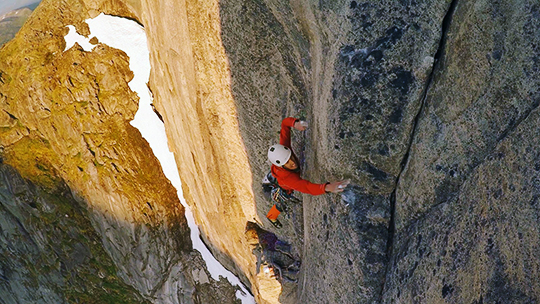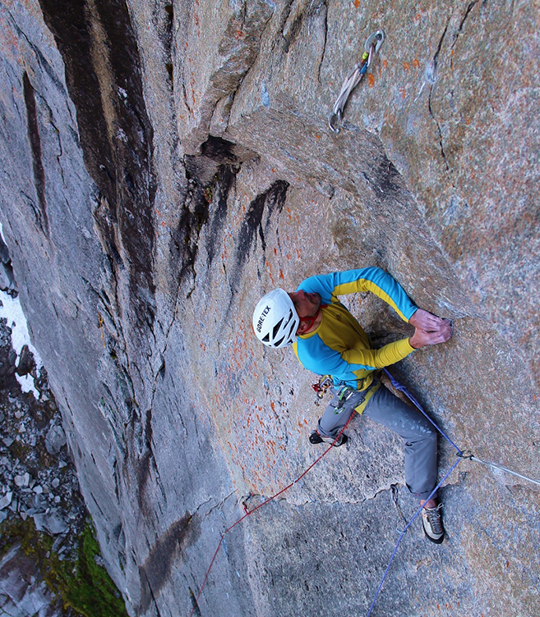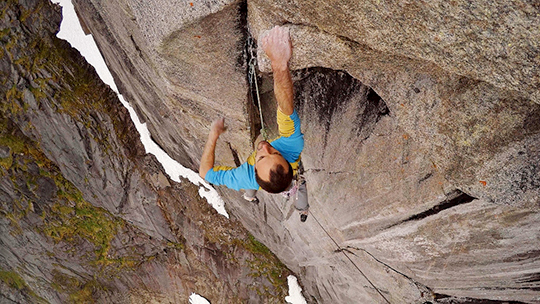
[Photo] Calum Muskett
A glimpse of bolts in an unlikely place sparked the inspiration for opening a new free route on the steep north face of Store Blamann peak (1044m) on the island Kvaloya in Norway.
In 2011, Dave MacLeod was working on freeing the route Bongo Bar (A3, 400m, Blixt-Massih-Ekefalk, July 1988; FFA: 7b+/5.12c, MacLeod-Snihur, 2011) on the north face of Blamman when he noticed an incongruous bolted anchor alone in the vast, steep stone of the peak’s main face. “I could picture Marten Blixt hand drilling them by head-torch in some blizzard during their winter aid ascent in 2000,” he wrote on his blog. Intrigued, MacLeod imagined free climbing the wild terrain on that face, a prospect that would require a strong team and some luck with the weather on this island split by glacier-carved fjords and exposed to the arctic sea.
[For a comparison between Yosemite Decimal System and French free climbing grades, see this link–Ed.]

[Photo] Calum Muskett
Store Blamann peak has a steep north-facing wall of compact granite that contains several 400-meter climbs and offers the unique opportunity to climb in the sun in the middle of the night during summer. While most routes were put up with aid, free climbing opportunities abound. “As far as I know the entire right section of wall is devoid of free climbing and there’s certainly plenty of potential,” Calum Muskett told Alpinist.
This summer MacLeod and Jacob Cook arrived on Kvaloya and began exploring the free potential of Disco 2000. The route shares the first two pitches of Arctandria (A2+ 400m, Dahli-Nesheim-Nesheim, May 1981; FFA: 8a+/5.13c, Berthod-Quirici, 2005), which ascends an immaculate clean corner. Their work sessions were cut short by a four-day rainstorm.
After repeating the crux of Arctandria, they ventured onto steep terrain to investigate free climbing potential. Aiding the pitches to fix ropes involved nailing pitons up precarious expanding flakes. To maximize their use of a brief weather window before impending rain, MacLeod worked on freeing the first aid pitch while Cook aid-soloed above.

[Photo] Jacob Cook
Higher on the face, Cook encountered a crack switch across blank rock. Cook recalls the moment on his blog, “I spotted a jug miles out to my right.” While contemplating the distance to the jug, he remembered thinking, “I wonder if it would be possible to just jump to that?”
Soon fellow UK climber Calum Muskett joined the team.
A pendulum section low on the route contained “just enough crimps” to go free at 8a+, recalled MacLeod. After the face crux, the team encountered an overhanging finger crack seeping with wet black slime leading out through a roof. The positive locks allowed them to free climb the crack despite wet conditions at 7c.
The next major difficulty was the blank pendulum section Cook had reconnoitered on Pitch 7. While Cook imagined a wild dyno to the jug, MacLeod discovered a crimp sequence that bypassed the move. Undeterred, Cook was so inspired by the prospect of the massive leap that he tried anyway, taking several massive falls before finally completing the all-points-off dyno.
With little time remaining before the next storm, Muskett, who had freed fewer pitches so far, rappelled off to give MacLeod and Cook the best chance of finishing. In the growing light of the midsummer-arctic dawn, MacLeod and Cook faced a decision: a few pitches of easier climbing remained, a light rain began, and they could see a storm gathering over the sea. They rushed to the top minutes before the sky opened with a heavy rain, completing the first free ascent of Disco 2000.
“Allegedly the summer weather in Kvaloya was the worst in years and despite that we could still work around the rain,” Muskett said. However, “with the midnight sun you can take advantage of any windows of dry weather.”